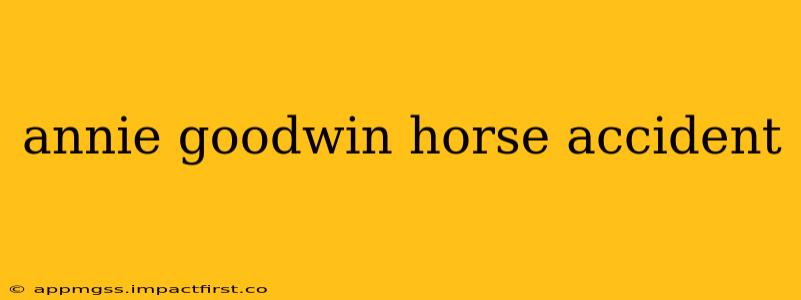The equestrian world was shocked and saddened by the devastating horse riding accident involving Annie Goodwin. While specific details surrounding the accident are often kept private out of respect for the involved parties, the incident highlights the inherent risks associated with horse riding and underscores the importance of safety precautions. This article explores the known aspects of the accident, addresses common questions surrounding such events, and offers insights into safety measures within the equestrian community. We aim to provide a respectful and informative overview, avoiding any speculation or invasion of privacy.
What Happened to Annie Goodwin?
Unfortunately, precise details regarding Annie Goodwin's accident remain largely undisclosed. This is common in such situations to protect the privacy of those involved and to allow for appropriate healing and processing. Respect for the individual's privacy is paramount. However, the equestrian community often shares collective grief and offers support following such events.
What Type of Horse Riding Accident Was It?
Again, specifics surrounding the type of accident are not publicly available. Horse riding accidents can vary greatly, from falls due to a horse tripping or spooking to more serious injuries sustained from a horse's kick or a fall resulting in impact with the ground or obstacles. The diversity of potential accidents highlights the multifaceted nature of risk management within the sport.
What are the Common Causes of Horse Riding Accidents?
Understanding the common causes of horse riding accidents is crucial for prevention. These can include:
- Inexperience: Inexperienced riders may lack the skills to manage unexpected situations, such as a horse suddenly bolting or rearing.
- Inadequate Training: Both horse and rider need proper training to ensure safe handling and communication. A horse improperly trained may react unpredictably.
- Unsafe Equipment: Faulty tack (saddles, bridles, etc.) or inappropriate riding attire can significantly increase the risk of accidents.
- Unpredictable Horse Behavior: Horses are powerful animals, and even the most well-trained horse can react unexpectedly to stimuli.
- Lack of Supervision: Especially for younger or less experienced riders, adequate supervision is essential to minimize risk.
- Environmental Hazards: Obstacles in the riding area or uneven terrain can lead to falls.
How Can Horse Riding Accidents Be Prevented?
Preventing horse riding accidents involves a multi-pronged approach encompassing rider skill, horse training, equipment, and environment. Key preventative measures include:
- Proper Training: Invest in professional riding lessons for both horse and rider.
- Regular Veterinary Checkups: Ensuring the horse's health and soundness through regular veterinary examinations.
- Safe Riding Practices: Always wear appropriate safety gear, including helmets, and ride in suitable locations with appropriate supervision.
- Appropriate Horse Selection: Choosing a horse that matches the rider's skill level and experience.
- Maintaining Equipment: Regularly checking and maintaining riding equipment for any defects or wear and tear.
- Risk Assessment: Regularly evaluating the riding environment for potential hazards.
What Safety Gear Should Be Worn While Horse Riding?
Safety gear is paramount in mitigating the risk of injury in horse riding. Essential safety gear includes:
- Helmet: A properly fitted riding helmet is non-negotiable.
- Protective Vest: A body protector can help absorb impact in the event of a fall.
- Gloves: Provide grip and protection for hands.
- Appropriate Footwear: Sturdy boots with a good heel to prevent slipping in the stirrups.
The unfortunate accident involving Annie Goodwin serves as a somber reminder of the inherent risks in horse riding. While specific details are not publicly available, focusing on safety precautions and preventative measures within the equestrian community is the best way to honor her and ensure the safety of all riders. Remember, responsible horse riding is a partnership requiring training, preparation, and respect for the power and unpredictability of the animal.
